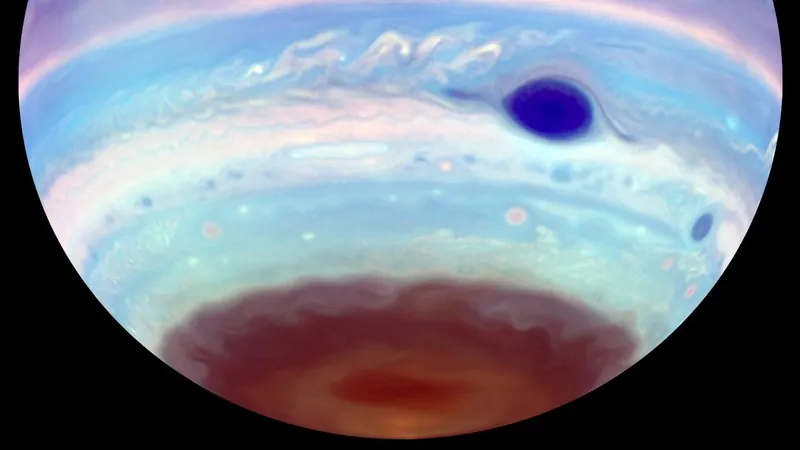
Jupiter's Magnetic Tornadoes Unleash Earth-Sized Storms - What This Means for Our Understanding of the Gas Giant
2024-11-26
Author: Yu
Jupiter's Magnetic Tornadoes Unleash Earth-Sized Storms - What This Means for Our Understanding of the Gas Giant
Planetary scientists have raised the alarm for a phenomenon unlike anything we've seen on Earth—magnetic tornadoes wreaking havoc on Jupiter, leading to the birth of colossal storms that could dwarf our planet. These magnetic vortices extend down from the gas giant's ionosphere into its vast, brooding atmosphere, creating massive anticyclones that absorb ultraviolet light and are comparable in size to Earth itself.
Visible only in ultraviolet light, these dark ovals were first detected at Jupiter’s poles by the Hubble Space Telescope in the late 1990s. The enigma behind their origin was partially solved by data collected from NASA’s Cassini spacecraft as it passed Jupiter in 2000. Despite early observations, the source of these gigantic storms remained a mystery—until now.
A team of researchers, led by Troy Tsubota from the University of California, Berkeley, has identified that these ominous dark ovals are products of magnetic tornadoes. The friction occurring between the magnetic field lines in Jupiter's incredibly powerful magnetic field generates these swirling tornadoes, channeling energy that leads to the development of these anticyclonic storms.
Tsubota noted the importance of annual imaging data from the Hubble Space Telescope, part of the Outer Planet Atmospheres Legacy (OPAL) project. This project is essential for monitoring the atmospheric changes across the giant planets in our solar system. The breathtaking images revealed that dark ovals appeared at Jupiter’s south pole three-quarters of the time from 2015 to 2022, while sightings at the north pole were much less frequent.
Like Earth, Jupiter’s magnetic field converges at its poles, allowing charged particles to spiral toward these regions and creating auroras. However, unlike the vibrant displays we witness from our planet’s magnetic storms, Jupiter’s auroras shine solely in ultraviolet light. This connection suggests that the mysterious dark ovals are tied to the planet's magnetic activities, just as auroras are influenced by magnetic field interactions on Earth.
The research team, which included experts like Michael Wong and Tom Stallard, rapidly collaborated to unveil the mystery behind these dark ovals. They hypothesized that the Io Plasma Torus—a donut-shaped ring made up of charged particles released by the intense volcanic activity on Jupiter’s moon Io—plays a significant role in generating these magnetic tornadoes. The friction between field lines in the Io Plasma Torus with those closer to Jupiter’s ionosphere could instigate the formation of swirling magnetic vortices. These vortices agitate aerosols in the stratosphere, generating the thick hazes observed.
Remarkably, the haze in these dark ovals is reported to be 50 times denser than the normal concentration, implying that the swirling dynamics of the tornadoes, rather than chemical reactions, are responsible for their creation. Intriguingly, observations reveal that the appearance of these dark ovals doesn’t correspond with spikes of charged particles arriving from the outer atmosphere; instead, they take about a month to form and fade within a few weeks.
As we peer further into the cosmic dance of Jupiter, it seems increasingly evident that this colossal gas giant resides in its own magnetic tornado alley. With each new discovery, our understanding of these mesmerizing phenomena only deepens—stimulating curiosity about not just Jupiter, but the foundational principles of planetary atmospheres in the universe. What other secrets might remain hidden within this gaseous giant's tempestuous embrace?




 Brasil (PT)
Brasil (PT)
 Canada (EN)
Canada (EN)
 Chile (ES)
Chile (ES)
 España (ES)
España (ES)
 France (FR)
France (FR)
 Hong Kong (EN)
Hong Kong (EN)
 Italia (IT)
Italia (IT)
 日本 (JA)
日本 (JA)
 Magyarország (HU)
Magyarország (HU)
 Norge (NO)
Norge (NO)
 Polska (PL)
Polska (PL)
 Schweiz (DE)
Schweiz (DE)
 Singapore (EN)
Singapore (EN)
 Sverige (SV)
Sverige (SV)
 Suomi (FI)
Suomi (FI)
 Türkiye (TR)
Türkiye (TR)